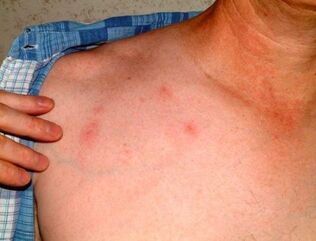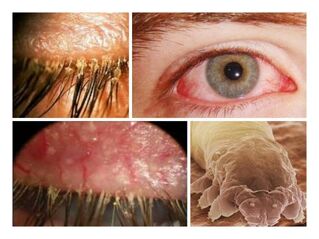
Photos and videos of symptoms of subcutaneous parasites in humans are not a pleasant sight. Unlike intestinal worms, which a person may not even know about, epithelial infections are easy to see. In this case, a person experiences constant discomfort due to the symptoms accompanying the injury. This helps to begin to diagnose the condition and to begin treatment as early as possible. A photo of subcutaneous parasites in humans evokes emotions close to disgust, but the symptoms of infection are much more unpleasant. The image does not convey the sensations of a person from the awareness that someone is crawling along their body. But epithelial infections are not only discomfort, but also a significant danger to the health of the whole organism. The toxins secreted by the body of the parasite can affect all organ systems, and the helminths themselves like to spread throughout the human body. Thus, the manifestation of dermatological problems can be a sign of danger to the patient's life due to the presence of helminths in the brain, organs of vision or the heart.
What parasites live in the skin?
Dermatological problems can cause a wide variety of infections. If, during an intestinal infection, the presence of worms is most often diagnosed, insects and protozoa can also be found under the skin. Mosquitoes, ticks and other blood-sucking parasites usually feed unnoticed and break away from humans, but some continue to live and reproduce in the body.
Each of these types of infections has its own unique ways of entering the human body. The symptoms and effects of the infection also vary widely. Accordingly, the treatment of the disease will proceed in different ways. But in order to distinguish one parasitic infection from another and determine who lives in the body, it is necessary to undergo a long diagnosis. The doctor, knowing the characteristics and habitats of different parasites, will suggest the most likely option even before testing begins, focusing only on the symptoms and the patient's travel map around the world.
Parasitic microorganisms
The most common disease of this type is leishmaniasis. It is caused by the simplest parasites, which gave the name to the pathology. 9 out of 10 infections occur in just a few countries:

- Syria;
- Iran;
- Saudi Arabia;
- Afghanistan;
- Peru;
- Brazil.
The disease is transmitted by mosquitoes and some species of flies. Pathogenic microorganisms do not survive in temperate climates, so you can only get infected with leishmaniasis after resting in hot countries with a tropical climate.
When infected, the infection forms ulcers at the site of insect bites. Over time, it heals and leaves a messy scar. With multiple foci, leishmaniasis can look like leprosy. The danger of this disease is that it passes from the skin to the lymphatic system and can affect internal organs, gradually destroying them. At the same time, the parasites live inside the cells, so the immune organisms are of little use in fighting the protozoa. But after just one experience of fighting leishmaniasis, immunity is formed.
Insects among subcutaneous parasites
Diseases caused by such an invasion are called entomoses. There are several varieties of these subcutaneous parasites in humans:
- Sarcopsillosis (tungiasis).Called by the tropical sand flea. It is enough to walk barefoot on the beach or to lie down in the sun, and the insect will crawl on the body. It hides imperceptibly under the outer layer of the epithelium until the blood is drunk. Then the chip "grows" and begins to press on the surrounding tissue, causing discomfort. When it dies, it is excreted from the body along with dead peeling skin. If this does not happen, the tissue can become infected and abscessed.
- Dermatobiosis.The South American human fly injects larvae under human skin. When they are fully developed, they tear tissue and leave the body, leaving an open wound. In case of damage to the eyelid and skin on the cartilage, adverse health consequences are possible.
- Acariosis.These diseases are caused by ticks. The most famous scabies, which lives and reproduces under the skin, feeding on its cells. Symptoms of scabies can be easily distinguished from itchy hives by filamentous stripes - ducts in the epithelium eaten away by the female parasite. Another mite, Demodex, causes dermatitis and baldness.

Most often, insects that settle in the human body live in southern countries, because their development requires a stable warm climate. But in some cases, it is enough to visit the sea in the summer and then fight against subcutaneous parasites for several months.
Parasitic roundworms and more
Subcutaneous worms in humans are not difficult to detect. They usually give out their location in the same way as other infections - with redness, itching and burning. But in some cases, the epithelium is only an intermediate stop, and the main development of the pathology continues in the internal organs:
- Heartworm.There are several types of these helminths. Some prefer to settle in internal organs, but there are those that affect the skin and eyes. The larvae of parasites are carried by mosquitoes and are found in warm regions. A painful, soft, mobile lump swells at the site of the injury. It is not dangerous if the infection does not affect the organs of vision. But it does require surgery for treatment.
- Dracunculiasis.The Rishta worm enters the body with water containing small crustaceans which store the larvae in their stomach. Through the intestines, helminths enter the abdominal cavity, where they mate and lay eggs in muscle tissue in the joints and bones of the legs. When the new worm matures, the larva pierces the skin and emerges. The only way to relieve the burning sensation and pain is to place the limb in water. Other methods of getting rid of the parasite that has taken up residence in the body have not yet been invented.
- Schistosomiasis.Not all worms under human skin get there with food. To get infected with schistosomes, all you need to do is swim in the fresh waters of tropical countries in South America, the Caribbean, Africa or Southeast Asia. The skin lesion resembles scabies and is accompanied by tingling. But after some time, the larvae penetrate deep into the body, after which the epithelial symptoms disappear and the next stage of the disease develops.
- Gnathostomosis.Humans are not natural hosts for this parasite. Therefore, worms cannot reproduce in the body. Therefore, the Asian parasite enters the body with insufficiently heat-treated fish, frogs or birds. The larvae begin to migrate after a month. Moving under the skin, they cause itching, redness and pain. The appearance in the abdomen is accompanied by edema.

After the first signs of life of helminths appear under the skin, the patient should be examined and begin treatment. Many parasites can significantly worsen health conditions, including disability, if they are not removed in time.
Diagnostic procedures
Given the variety of parasites living under a person's skin, there is no one-size-fits-all method that would help identify the cause of the disease. In addition, we must not forget that insects and worms are not the only possible sources of dermatological problems. Allergic reactions, fungal growth, and bacterial infections are much more likely to cause hives and dermatitis.
The first step in testing human skin for parasites begins with an examination. The doctor investigates, examines the affected areas and asks for other symptoms. He may therefore restrict the search area and, in certain cases, for example, with dracunculiasis and heartworm, immediately prescribe treatment.
If the physical examination did not completely clarify the picture, laboratory and material diagnostic methods are assigned:
- Blood test.General analysis reveals the picture of the body's reactions to infection. A specialist can therefore determine the nature of the disease. During biochemistry, attention should be paid to indicators of the rate of erythrocyte sedimentation and the content of eosinophils. If they are high, it means that helminthiasis is very likely. ELISA analysis is the most accurate. This will help determine by the presence of antibodies, even the exact type of parasite, if it is present in the body.
- Stool analysis.Many subcutaneous worms are initially based inside the intestines. By examining the feces, you can find helminth eggs and start treatment.
- Biopsy.Analysis of affected tissues, the contents of purulent abscesses and blisters, swollen lymph nodes can also reveal a picture of the disease.
- Ultrasound, X-rays, CT and MRI.Various physical methods of "sweeping" the body will help locate the source of infection under the skin and in internal organs. In some cases, this is the only effective diagnostic method.

Some infections can only be diagnosed after treatment, when the parasite is shed under the skin.
Treatment of parasitic diseases
Depending on the type of parasite, doctors should use different methods to get rid of the infection:
- The simplest microorganisms are destroyed with a course of antibiotics. It is necessarily accompanied by symptomatic treatment.
- You can get rid of ticks by using specialized ointments and tablets. At the same time, dermatobiosis can be cured only by surgery, removing the larvae from under the skin.
- The method of treating helminthiasis depends directly on the type of parasite. Heartworm disease is therefore only treated surgically. Antihelmetics will help get rid of schistosomes and intestinal parasites. And the treatment for dracunculiasis is not provided at all. A person has to wait for the worm to leave their body and fight the symptoms: pain and inflammation.
In any case, it is necessary to undergo a comprehensive examination by a doctor and begin treatment under his direction in order to ensure complete elimination of parasites.






































